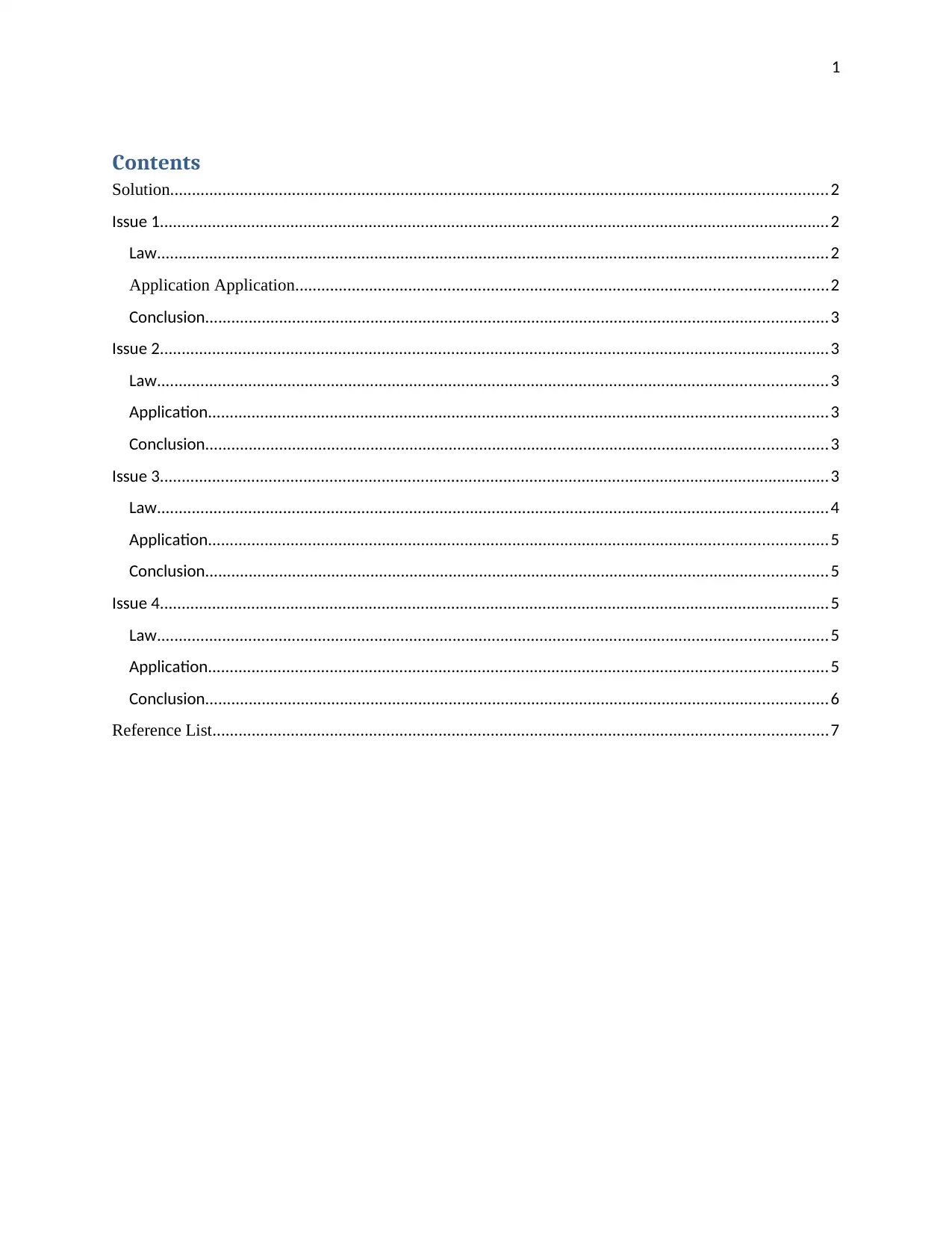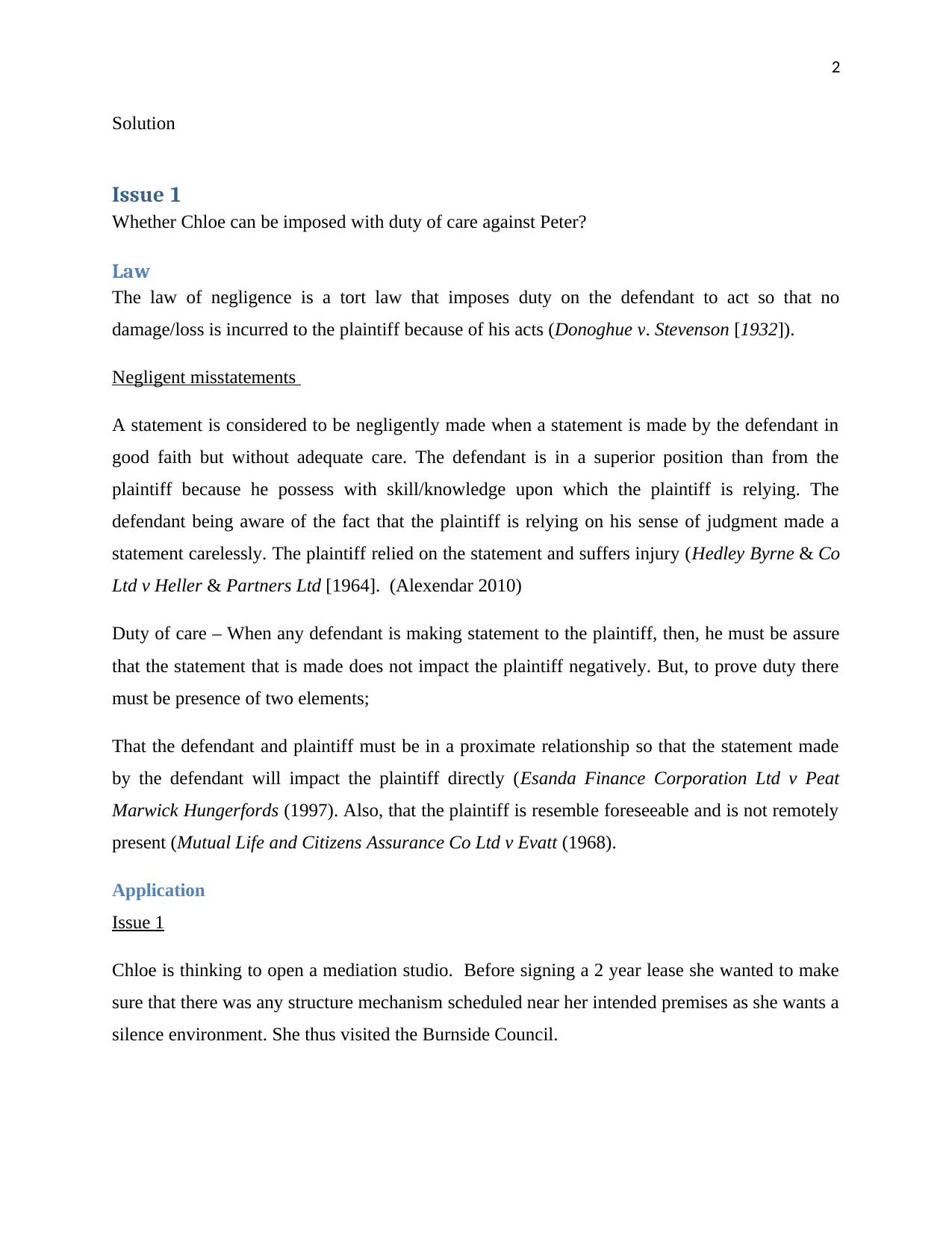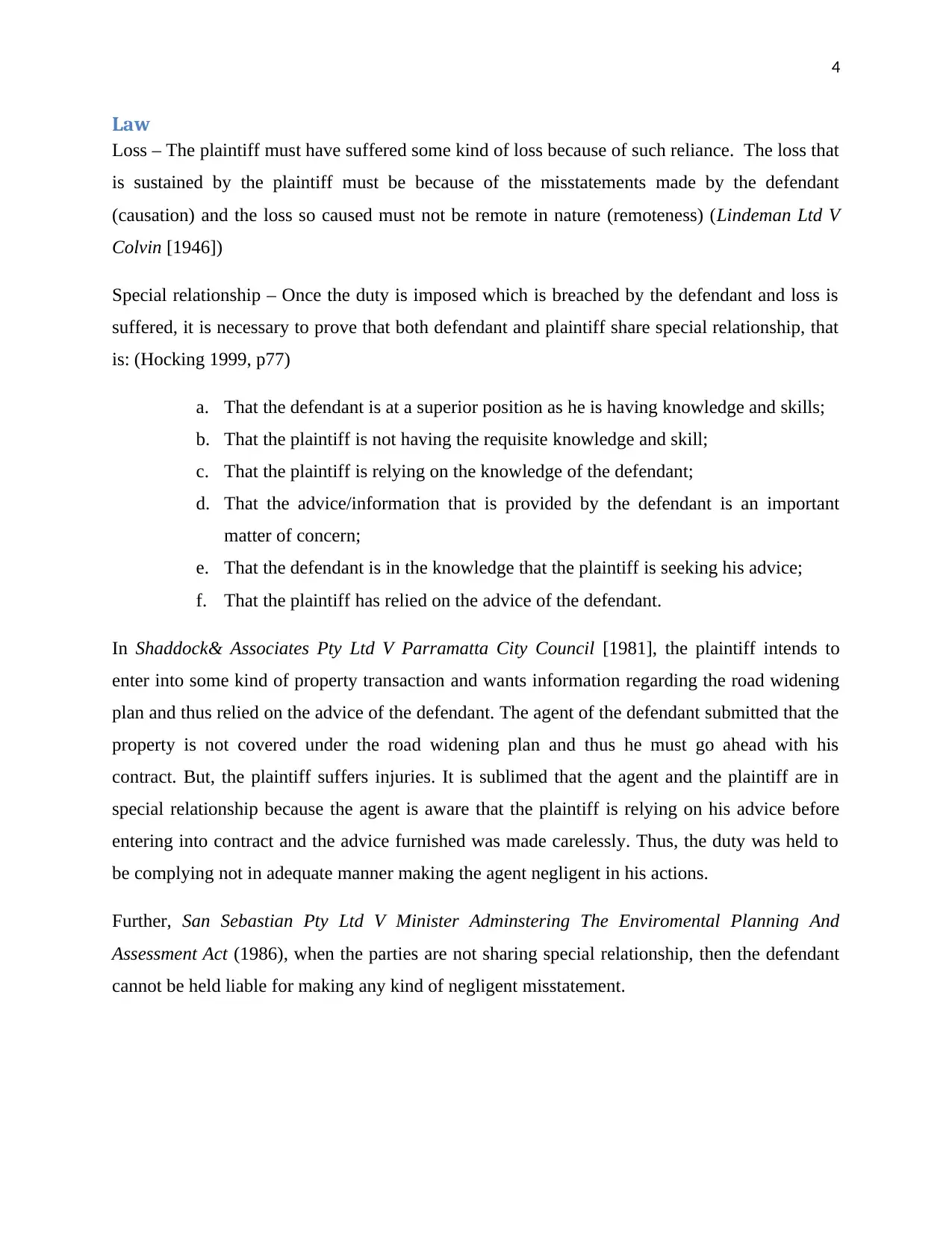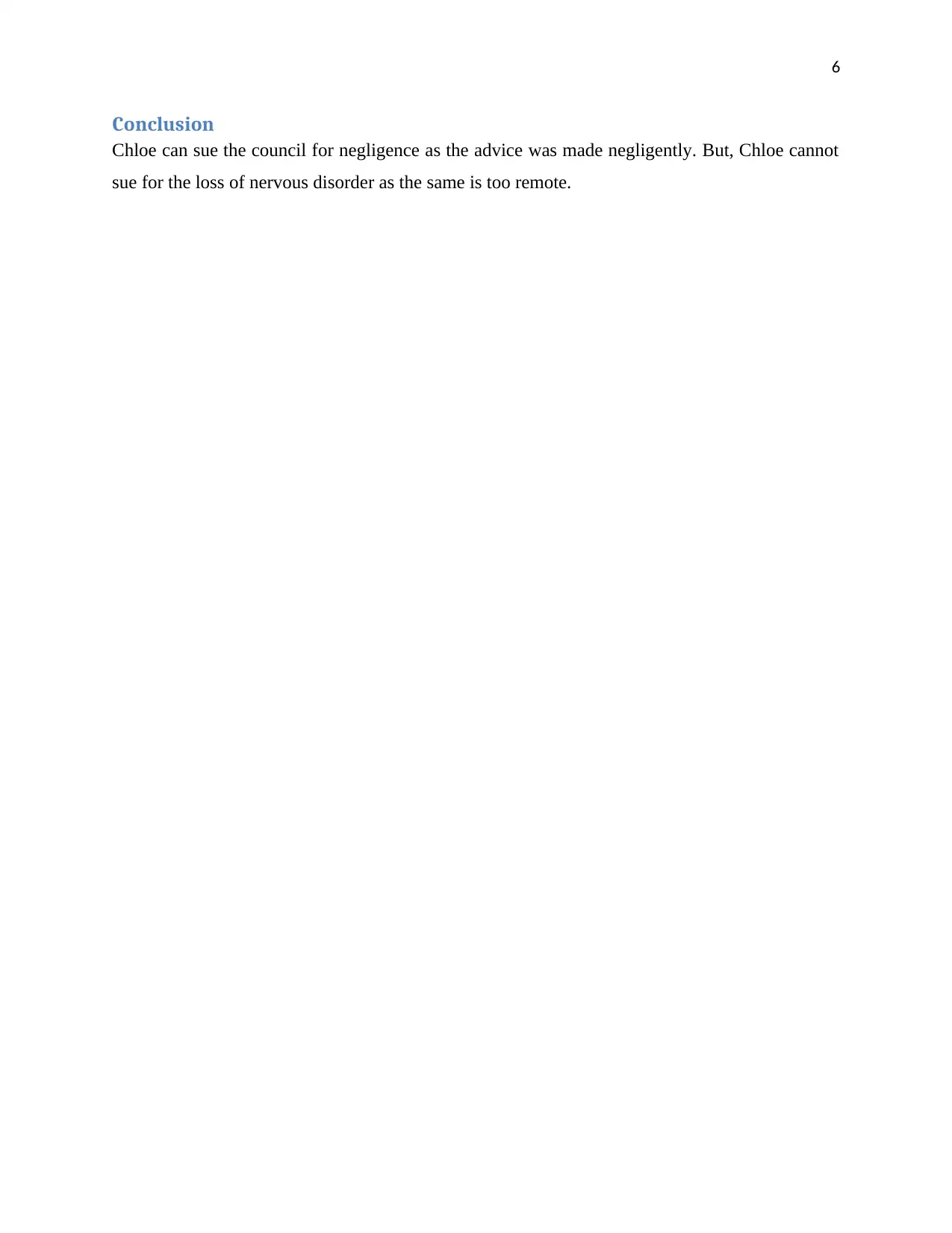Duty of Care and Negligent Misstatement: Chloe's Case Study
VerifiedAdded on 2021/06/18
|8
|1605
|48
Case Study
AI Summary
This case study examines a negligence claim brought by Chloe against Burnside Council. Chloe, planning to open a mediation studio, sought information from the council about potential construction near her intended premises. The council attendant provided information based on a superficial computer check, which turned out to be inaccurate. Relying on this information, Chloe signed a two-year lease, only to be disrupted by major construction work after six months, leading to business disruption and a nervous disorder. The analysis delves into the legal principles of negligence, duty of care, negligent misstatement, breach of duty, causation, and remoteness of damages. It determines whether the council owed Chloe a duty of care, whether that duty was breached, and whether the resulting damages were foreseeable and directly caused by the council's actions, ultimately concluding on the council's liability.

1
Contents
Solution.......................................................................................................................................................2
Issue 1..........................................................................................................................................................2
Law..........................................................................................................................................................2
Application Application..........................................................................................................................2
Conclusion...............................................................................................................................................3
Issue 2..........................................................................................................................................................3
Law..........................................................................................................................................................3
Application..............................................................................................................................................3
Conclusion...............................................................................................................................................3
Issue 3..........................................................................................................................................................3
Law..........................................................................................................................................................4
Application..............................................................................................................................................5
Conclusion...............................................................................................................................................5
Issue 4..........................................................................................................................................................5
Law..........................................................................................................................................................5
Application..............................................................................................................................................5
Conclusion...............................................................................................................................................6
Reference List.............................................................................................................................................7
Contents
Solution.......................................................................................................................................................2
Issue 1..........................................................................................................................................................2
Law..........................................................................................................................................................2
Application Application..........................................................................................................................2
Conclusion...............................................................................................................................................3
Issue 2..........................................................................................................................................................3
Law..........................................................................................................................................................3
Application..............................................................................................................................................3
Conclusion...............................................................................................................................................3
Issue 3..........................................................................................................................................................3
Law..........................................................................................................................................................4
Application..............................................................................................................................................5
Conclusion...............................................................................................................................................5
Issue 4..........................................................................................................................................................5
Law..........................................................................................................................................................5
Application..............................................................................................................................................5
Conclusion...............................................................................................................................................6
Reference List.............................................................................................................................................7
Paraphrase This Document
Need a fresh take? Get an instant paraphrase of this document with our AI Paraphraser

2
Solution
Issue 1
Whether Chloe can be imposed with duty of care against Peter?
Law
The law of negligence is a tort law that imposes duty on the defendant to act so that no
damage/loss is incurred to the plaintiff because of his acts (Donoghue v. Stevenson [1932]).
Negligent misstatements
A statement is considered to be negligently made when a statement is made by the defendant in
good faith but without adequate care. The defendant is in a superior position than from the
plaintiff because he possess with skill/knowledge upon which the plaintiff is relying. The
defendant being aware of the fact that the plaintiff is relying on his sense of judgment made a
statement carelessly. The plaintiff relied on the statement and suffers injury (Hedley Byrne & Co
Ltd v Heller & Partners Ltd [1964]. (Alexendar 2010)
Duty of care – When any defendant is making statement to the plaintiff, then, he must be assure
that the statement that is made does not impact the plaintiff negatively. But, to prove duty there
must be presence of two elements;
That the defendant and plaintiff must be in a proximate relationship so that the statement made
by the defendant will impact the plaintiff directly (Esanda Finance Corporation Ltd v Peat
Marwick Hungerfords (1997). Also, that the plaintiff is resemble foreseeable and is not remotely
present (Mutual Life and Citizens Assurance Co Ltd v Evatt (1968).
Application
Issue 1
Chloe is thinking to open a mediation studio. Before signing a 2 year lease she wanted to make
sure that there was any structure mechanism scheduled near her intended premises as she wants a
silence environment. She thus visited the Burnside Council.
Solution
Issue 1
Whether Chloe can be imposed with duty of care against Peter?
Law
The law of negligence is a tort law that imposes duty on the defendant to act so that no
damage/loss is incurred to the plaintiff because of his acts (Donoghue v. Stevenson [1932]).
Negligent misstatements
A statement is considered to be negligently made when a statement is made by the defendant in
good faith but without adequate care. The defendant is in a superior position than from the
plaintiff because he possess with skill/knowledge upon which the plaintiff is relying. The
defendant being aware of the fact that the plaintiff is relying on his sense of judgment made a
statement carelessly. The plaintiff relied on the statement and suffers injury (Hedley Byrne & Co
Ltd v Heller & Partners Ltd [1964]. (Alexendar 2010)
Duty of care – When any defendant is making statement to the plaintiff, then, he must be assure
that the statement that is made does not impact the plaintiff negatively. But, to prove duty there
must be presence of two elements;
That the defendant and plaintiff must be in a proximate relationship so that the statement made
by the defendant will impact the plaintiff directly (Esanda Finance Corporation Ltd v Peat
Marwick Hungerfords (1997). Also, that the plaintiff is resemble foreseeable and is not remotely
present (Mutual Life and Citizens Assurance Co Ltd v Evatt (1968).
Application
Issue 1
Chloe is thinking to open a mediation studio. Before signing a 2 year lease she wanted to make
sure that there was any structure mechanism scheduled near her intended premises as she wants a
silence environment. She thus visited the Burnside Council.

3
It is submitted that Chloe shares a special relationship with the attendant of the council. The
council is aware of the actual position of whether there are chances of any building work or not
and Chloe is not aware of the same. Chloe is relying on the information provided by the
attendant before entering into any contract.
It is submitted that since the attendants and Chloe are sharing special relationship, thus, the
attends owns a duty against Chloe.
Conclusion
Thus, there is duty of care
Issue 2
Whether the duty is violated?
Law
Breach - It is necessary that the defendant must be aware that the plaintiff is relying on his sense
of judgment and on the statements made by him before entering into any contractual relationship
and the defendant has acted without adequate care resulting in breach. The duty is violated when
the standard/level of precaution/care that is expected from the defendant is not met like a normal
prudent man in the similar circumstances (Roads and Traffic Authority of NSW v Refrigerated
Roadways Pty Limited [2009]
Application
The duty of care is not met by the attendant as when Chloe shared her concern with the attendant
then the attendant checked the computer with superficial glance and submitted that there is no
building work scheduled. So, the level of care that is expected from the attendant is not met.
Conclusion
Thus, the level of care is not met by the attendant as expected from him in the given situation
like a prudent man in the like situation.
Issue 3
Are there any damages caused because of breach of duty?
It is submitted that Chloe shares a special relationship with the attendant of the council. The
council is aware of the actual position of whether there are chances of any building work or not
and Chloe is not aware of the same. Chloe is relying on the information provided by the
attendant before entering into any contract.
It is submitted that since the attendants and Chloe are sharing special relationship, thus, the
attends owns a duty against Chloe.
Conclusion
Thus, there is duty of care
Issue 2
Whether the duty is violated?
Law
Breach - It is necessary that the defendant must be aware that the plaintiff is relying on his sense
of judgment and on the statements made by him before entering into any contractual relationship
and the defendant has acted without adequate care resulting in breach. The duty is violated when
the standard/level of precaution/care that is expected from the defendant is not met like a normal
prudent man in the similar circumstances (Roads and Traffic Authority of NSW v Refrigerated
Roadways Pty Limited [2009]
Application
The duty of care is not met by the attendant as when Chloe shared her concern with the attendant
then the attendant checked the computer with superficial glance and submitted that there is no
building work scheduled. So, the level of care that is expected from the attendant is not met.
Conclusion
Thus, the level of care is not met by the attendant as expected from him in the given situation
like a prudent man in the like situation.
Issue 3
Are there any damages caused because of breach of duty?
⊘ This is a preview!⊘
Do you want full access?
Subscribe today to unlock all pages.

Trusted by 1+ million students worldwide

4
Law
Loss – The plaintiff must have suffered some kind of loss because of such reliance. The loss that
is sustained by the plaintiff must be because of the misstatements made by the defendant
(causation) and the loss so caused must not be remote in nature (remoteness) (Lindeman Ltd V
Colvin [1946])
Special relationship – Once the duty is imposed which is breached by the defendant and loss is
suffered, it is necessary to prove that both defendant and plaintiff share special relationship, that
is: (Hocking 1999, p77)
a. That the defendant is at a superior position as he is having knowledge and skills;
b. That the plaintiff is not having the requisite knowledge and skill;
c. That the plaintiff is relying on the knowledge of the defendant;
d. That the advice/information that is provided by the defendant is an important
matter of concern;
e. That the defendant is in the knowledge that the plaintiff is seeking his advice;
f. That the plaintiff has relied on the advice of the defendant.
In Shaddock& Associates Pty Ltd V Parramatta City Council [1981], the plaintiff intends to
enter into some kind of property transaction and wants information regarding the road widening
plan and thus relied on the advice of the defendant. The agent of the defendant submitted that the
property is not covered under the road widening plan and thus he must go ahead with his
contract. But, the plaintiff suffers injuries. It is sublimed that the agent and the plaintiff are in
special relationship because the agent is aware that the plaintiff is relying on his advice before
entering into contract and the advice furnished was made carelessly. Thus, the duty was held to
be complying not in adequate manner making the agent negligent in his actions.
Further, San Sebastian Pty Ltd V Minister Adminstering The Enviromental Planning And
Assessment Act (1986), when the parties are not sharing special relationship, then the defendant
cannot be held liable for making any kind of negligent misstatement.
Law
Loss – The plaintiff must have suffered some kind of loss because of such reliance. The loss that
is sustained by the plaintiff must be because of the misstatements made by the defendant
(causation) and the loss so caused must not be remote in nature (remoteness) (Lindeman Ltd V
Colvin [1946])
Special relationship – Once the duty is imposed which is breached by the defendant and loss is
suffered, it is necessary to prove that both defendant and plaintiff share special relationship, that
is: (Hocking 1999, p77)
a. That the defendant is at a superior position as he is having knowledge and skills;
b. That the plaintiff is not having the requisite knowledge and skill;
c. That the plaintiff is relying on the knowledge of the defendant;
d. That the advice/information that is provided by the defendant is an important
matter of concern;
e. That the defendant is in the knowledge that the plaintiff is seeking his advice;
f. That the plaintiff has relied on the advice of the defendant.
In Shaddock& Associates Pty Ltd V Parramatta City Council [1981], the plaintiff intends to
enter into some kind of property transaction and wants information regarding the road widening
plan and thus relied on the advice of the defendant. The agent of the defendant submitted that the
property is not covered under the road widening plan and thus he must go ahead with his
contract. But, the plaintiff suffers injuries. It is sublimed that the agent and the plaintiff are in
special relationship because the agent is aware that the plaintiff is relying on his advice before
entering into contract and the advice furnished was made carelessly. Thus, the duty was held to
be complying not in adequate manner making the agent negligent in his actions.
Further, San Sebastian Pty Ltd V Minister Adminstering The Enviromental Planning And
Assessment Act (1986), when the parties are not sharing special relationship, then the defendant
cannot be held liable for making any kind of negligent misstatement.
Paraphrase This Document
Need a fresh take? Get an instant paraphrase of this document with our AI Paraphraser

5
Application
Based on the advice, a 2 year lease signed is sign by Chloe. But, after 6 months a major
construction work started. The noise has caused problem to Chloe to carry out his work. She
suffered nervous disorder.
Thus, because of breach of duty of care loss is caused to the Chloe. However, the council is not
liable for the nervous disorder of Chloe as the loss is too remote.
Conclusion
Thus, the council is negligent for the negligent miss -statements made by the attendant.
Issue 4
Whether Chloe can sue Burnside Council for his nervous disorder?
Law
When any act of negligence is caused then it is necessary that the acts of the defendant must have
caused loss to the plaintiff. It is necessary that there is legal duty of care imposed upon the
defendant who is not complying with by him resulting in loss to the plaintiff.
However, there are two elements to be proved:
i. Remoteness – that the loss should be such that is not unpredictable by the defendant.
If the loss is such that no reasonable person could have anticipated that because of his
acts some loss is cased to the plaintiff, then, the loss is too remote and the defendant
cannot be held liable under the law of negligence and is rightly established in the
leading case of South Australia Asset Management Corp v York Montague Ltd,
[1997].
ii. Causation – Also, it is necessary that the loss must be because of the acts of the
defendant. If the loss is caused because of some other means then there is lack of
causation and the defendant is not negligent.
Application
Because of the attendant Chloe has suffered losses and thus Chloe has moved out of the
premises.
The loss that is caused to Chloe, mental disorder, is though caused by the acts of the council but
the loss is too remote for the council to predict. So, there is remoteness in the loss that is caused
to Chloe and council cannot be held liable for such losses.
Application
Based on the advice, a 2 year lease signed is sign by Chloe. But, after 6 months a major
construction work started. The noise has caused problem to Chloe to carry out his work. She
suffered nervous disorder.
Thus, because of breach of duty of care loss is caused to the Chloe. However, the council is not
liable for the nervous disorder of Chloe as the loss is too remote.
Conclusion
Thus, the council is negligent for the negligent miss -statements made by the attendant.
Issue 4
Whether Chloe can sue Burnside Council for his nervous disorder?
Law
When any act of negligence is caused then it is necessary that the acts of the defendant must have
caused loss to the plaintiff. It is necessary that there is legal duty of care imposed upon the
defendant who is not complying with by him resulting in loss to the plaintiff.
However, there are two elements to be proved:
i. Remoteness – that the loss should be such that is not unpredictable by the defendant.
If the loss is such that no reasonable person could have anticipated that because of his
acts some loss is cased to the plaintiff, then, the loss is too remote and the defendant
cannot be held liable under the law of negligence and is rightly established in the
leading case of South Australia Asset Management Corp v York Montague Ltd,
[1997].
ii. Causation – Also, it is necessary that the loss must be because of the acts of the
defendant. If the loss is caused because of some other means then there is lack of
causation and the defendant is not negligent.
Application
Because of the attendant Chloe has suffered losses and thus Chloe has moved out of the
premises.
The loss that is caused to Chloe, mental disorder, is though caused by the acts of the council but
the loss is too remote for the council to predict. So, there is remoteness in the loss that is caused
to Chloe and council cannot be held liable for such losses.

6
Conclusion
Chloe can sue the council for negligence as the advice was made negligently. But, Chloe cannot
sue for the loss of nervous disorder as the same is too remote.
Conclusion
Chloe can sue the council for negligence as the advice was made negligently. But, Chloe cannot
sue for the loss of nervous disorder as the same is too remote.
⊘ This is a preview!⊘
Do you want full access?
Subscribe today to unlock all pages.

Trusted by 1+ million students worldwide

7
Reference List
Books/Articles/Journals
Hocking, B. (1999). Liability for negligent words. Sydney: Federation Press.
ALEXANDER, D. (2010). Material Misstatement of What? A Comment on Smieliauskas
et Abacus, 46(4). < https://onlinelibrary.wiley.com/doi/pdf/10.1111/j.1467-6281.2010.00327.x>.
Case law
Bank Line Ltd v Arthur Capel & Co [1919].
Donoghue v. Stevenson [1932]).
Esanda Finance Corporation Ltd v Peat Marwick Hungerfords (1997) 188 CLR 241 (HCA);
Hedley Byrne & Co Ltd v Heller & Partners Ltd [1964] AC 465.
Mutual Life and Citizens Assurance Co Ltd v Evatt (1968) 122 CLR 566.
Roads and Traffic Authority of NSW v Refrigerated Roadways Pty Limited [2009]
Shaddock& Associates Pty Ltd V Parramatta City Council [1981] HCA 59.
South Australia Asset Management Corp v York Montague Ltd, [1997] 1 A.C. 191 HL
San Sebastian Pty Ltd V Minister Adminstering The Enviromental Planning And Assessment Act
(1986).
Reference List
Books/Articles/Journals
Hocking, B. (1999). Liability for negligent words. Sydney: Federation Press.
ALEXANDER, D. (2010). Material Misstatement of What? A Comment on Smieliauskas
et Abacus, 46(4). < https://onlinelibrary.wiley.com/doi/pdf/10.1111/j.1467-6281.2010.00327.x>.
Case law
Bank Line Ltd v Arthur Capel & Co [1919].
Donoghue v. Stevenson [1932]).
Esanda Finance Corporation Ltd v Peat Marwick Hungerfords (1997) 188 CLR 241 (HCA);
Hedley Byrne & Co Ltd v Heller & Partners Ltd [1964] AC 465.
Mutual Life and Citizens Assurance Co Ltd v Evatt (1968) 122 CLR 566.
Roads and Traffic Authority of NSW v Refrigerated Roadways Pty Limited [2009]
Shaddock& Associates Pty Ltd V Parramatta City Council [1981] HCA 59.
South Australia Asset Management Corp v York Montague Ltd, [1997] 1 A.C. 191 HL
San Sebastian Pty Ltd V Minister Adminstering The Enviromental Planning And Assessment Act
(1986).
Paraphrase This Document
Need a fresh take? Get an instant paraphrase of this document with our AI Paraphraser

8
1 out of 8
Related Documents
Your All-in-One AI-Powered Toolkit for Academic Success.
+13062052269
info@desklib.com
Available 24*7 on WhatsApp / Email
![[object Object]](/_next/static/media/star-bottom.7253800d.svg)
Unlock your academic potential
Copyright © 2020–2025 A2Z Services. All Rights Reserved. Developed and managed by ZUCOL.





